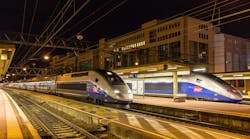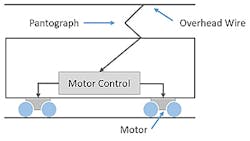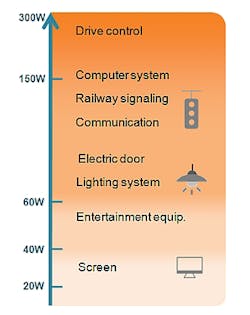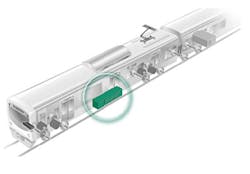The Surging Need for Power Density in Railway Systems
This article is part of the Power Management Series: Delving Into Power Density
Members can download this article in PDF format.
What you'll learn:
- Why the need for increased power density in railway systems?
- Why dc electrification is best for these types of systems.
- How VVVF inverters increase power density.
- The advent of hydrogen-fuel-cell hybrid railway system.
Europe was the first region to develop railways, so it makes sense that the international standards related to railways in that region also have been perfected.
Trains experience long-term exposure in harsh environments, with extreme temperature variations, dust, and vibration, as well as voltage fluctuations and transients of electrical equipment. Thus, EN50155, the most commonly used specification in Europe, not only lists the working condition of electrical equipment and the voltage range of power supplies, but also conditions of reliability.
In particular, electrically powered trains absolutely need good power-density designs. The following sections will demonstrate why this is necessary.
Electrical Traction Systems
Track electrification is the type of source supply system used while powering all electric locomotive systems. This can be ac or dc, or even a composite supply.
There are three main forms of electric traction systems:
- Direct-current (dc) electrification system
- Alternating-current (ac) electrification system
- Composite system
Direct current can vary with 300, 500, 600, 750, 1200, 1500, and 3000 V dc. Alternating current varies with 15 kV ac @16.7 Hz or 25 kV ac @50/60 Hz. And there’s a composite system with 1.5 kV dc, 3 kV ac @16.7 Hz, or 25 kV ac @ 50 Hz
DC Electrification Systems
A dc electrification system1 is best for space and weight, is lower cost than ac systems, and consumes less energy than ac or composite system designs. This method of employing dc is best for optimum power density:
- In the case of heavy trains, which have frequent and rapid acceleration, dc traction motors are a better choice versus ac motors.
- A dc train will consume less energy as compared to an ac unit with the same operating service conditions.
- Equipment in dc traction systems is less costly and lighter with higher efficiency than ac traction systems.
- DC systems will cause no electrical interference with nearby communication lines.
In the dc electrification system, three-phase high-voltage power is taken from the power grids and converted to low-voltage dc by rectifiers and power-electronic converters (PECs) (Fig. 1).
The dc supply can be supplied to the train vehicle in two ways:
- 3rd and 4th rail systems that are operated at low voltages (600 to 1200 V).
- Overhead wire rail systems that have high voltages (1500 to 3000 V).
DC electrification supply systems include:
- 300- to 500-V supply for special systems such as battery systems.
- 600 to 1200 V are for urban railways such as tramways and light metro trains.
- 1500 to 3000 V are for suburban and mainline services such as light metros as well as heavy metro trains.
Because of high starting torque and moderate speed control, dc series motors are widely used in dc traction systems. The advantage is that they provide high torque at low speeds and low torque at high speeds.
Where is Power Density in Railway Systems?
In modern times, trains have added functions of convenience and entertainment, like information display screens, charging sockets, vending machines, etc. This trend in additional equipment leads to ever-increasing power of the power converter, and under the limited space within the train, it must maintain the same volume or even shrink. As a result, the power supply for railways—with high power density—will be a trend going forward.
The railway computer system is the central control for the entire train, which controls such electrical equipment as the smoke detector, IP cameras, door control, air conditioning, and broadcasters in each cabin.
The different types of equipment on the train will have different power requirements (Fig. 2). Drive control and power control require quite a bit of energy to drive these systems, usually at 200 to 300 W. The computer and railway signaling system are the main cores of the train, and their power can be 150 W or more.
Auxiliary electric doors and lighting equipment are powered by the auxiliary power supply on the train. In addition, communication equipment like emergency intercoms, monitors, broadcasts, etc., is powered by the vehicle using dc-dc converters converted to the necessary voltages. Typical power is usually 70 to 150 W.
Entertainment equipment and screens use low and medium power of 20 to 60 W. Power density is crucial in all of the above systems due to the need to power a myriad of functions in a small form factor.
Improved Power Density with Induction Motors for Better Railway Traction
Power inverters bring higher current capacity to a design, which improves the power density of a railway traction motor.2 Regenerative braking also will increase energy savings.
Employing variable-voltage variable-frequency (VVVF) inverters using 3.3-kV Si-IGBT devices has been mainly applied to the induction motor traction systems of railway vehicles under the dc 1.5-kV line voltage (Fig. 3). In recent years, wide-bandgap (WBG) semiconductor devices, such as 3.3-kV SiC MOSFETs, also are applied to the railway vehicle for dc 1.5-kV sections.
Thanks to the lower conduction loss and higher operation temperature characteristics of SiC devices, the current capacity of the SiC MOSFET is higher under the same loss conditions of the Si IGBT. Therefore, the higher powering performance and the higher regenerative brake performance are expected to save energy consumption with the railway vehicle running.
Hydrogen-Fuel-Cell Hybrid Railway Systems
Important players in the hydrogen-fuel-cell (HFC) hybrid railway system are step-up dc-dc converters. That’s because the HFC has difficulty directly generating a high link voltage of over 1500 V for the high-power capacity inverter driving the traction motor in the vehicle. Step-up dc-dc converters demand a high conversion efficiency with low weight and volume due to the limited space in railway vehicles—hence, power density is highly important here.
Interleaved boost converters as well as three-level boost converters, are promising topologies for the HFC hybrid railway system, especially in terms of them being lightweight. However, the three-level boost converter is the more promising topology for a HFC hybrid railway system than the interleaved boost converter because of its high efficiency and high power density.
Summary
This article reveals that dc electrification systems enhance space and decrease weight. Such systems in railway also cost less overall than ac systems, and they have lower energy consumption than both ac and composite system designs. Ultimately, dc power offers optimum power density in railway systems. Finally, the examples presented outline various types of electric railway systems with good power-density solutions.
Read more articles in the Power Management Series: Delving Into Power Density
References
1. Everything about rail systems, railsystem.net/electric traction systems
2. Study on Design Method for Increasing Power Density of Induction Motors for Electric Railway Vehicle Traction, IEEE 2019
3. Study on Boost Converters with High Power-Density for Hydrogen-Fuel-Cell Hybrid Railway System, Electronics 2020/MDPI
4. High Performance Electrical Machines for Electrical Propulsion, PEMC Research Group
5. Demands of Power Supplies in Railway Applications | Coil Technology Corporation (powerctc.com)



